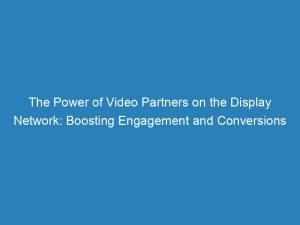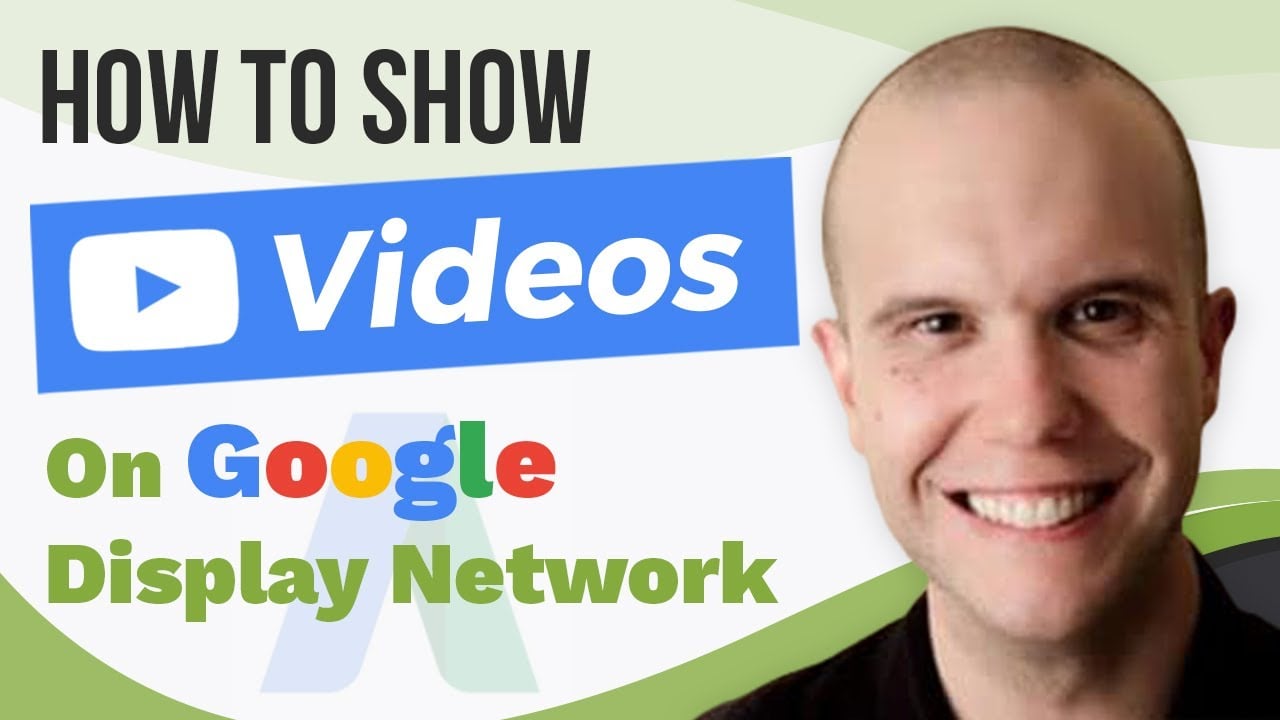The digital world is an ever-expanding universe of possibilities, where advertisers constantly strive to connect with their target audience in innovative ways. And just when we thought we knew all there was to know about videoadvertising on Google, a new frontier has emerged.
Google Ads has now unlocked the power of Google video partners on the display network, opening up a world of high-quality publisher websites and mobile apps where video ads can thrive beyond the realms of YouTube. This groundbreaking development offers advertisers unprecedented control over ad placement and the potential to skyrocket their reach and conversions.
Buckle up, because we’re about to embark on an exhilarating journey through the realm of videoadvertising like never before!
Table of Contents
- video partners on the display network
- Introduction To Google Video Partners On The Display Network
- Benefits Of Using Google Video Partners For Video Action Campaigns
- Control Features For Ads On Google Video Partners
- Increase Reach And Conversions With Google Video Partners
- Supported Goals For Ads On Google Video Partners
- Campaign Subtypes For Video Action Campaigns On Google Video Partners
- Pricing Models For Ads On Google Video Partners
- Ad Formats And Targeting Options For Google Video Partners
video partners on the display network
Video partners on the display network refer to the high-quality publisher websites and mobile apps where video ads can be displayed beyond YouTube in video action campaigns on Google Ads. These video partner publishers are carefully vetted and must meet Google’s inventory quality standards and ad management platform policies.
Adding Google video partners to campaigns provides several benefits, including showing ads on brand-aligned content across devices and having control over ad placement. This control is achieved through audience targeting, content targeting, and content exclusions features, allowing advertisers to exclude sensitive or irrelevant content.
By including Google video partners in Video action campaigns with Target CPA bidding, advertisers can expect to gain additional reach and potentially achieve more conversions at lower costs. There are various campaign subtypes, pricing models, ad formats, targeting options, and bidding options available for utilizing Google video partners on the display network.Key Points:
- Video partners on the display network are high-quality publisher websites and mobile apps where video ads can be displayed beyond YouTube.
- These video partner publishers must meet Google’s inventory quality standards and ad management platform policies.
- Adding Google video partners to campaigns allows ads to be shown on brand-aligned content on multiple devices.
- Advertisers have control over ad placement through audience targeting, content targeting, and content exclusions features.
- Including Google video partners in Video action campaigns with Target CPA bidding can result in additional reach and potentially lower costs.
- There are various campaign subtypes, pricing models, ad formats, targeting options, and bidding options available for utilizing Google video partners on the display network.
Sources
https://support.google.com/google-ads/answer/7166933?hl=en
https://support.google.com/google-ads/answer/2375497?hl=en
https://support.google.com/google-ads/answer/117120?hl=en
https://www.youtube.com/watch?v=wMxJCbzIjvo
Check this out:
💡 Pro Tips:
1. Utilize the control features offered by Google video partners to ensure your ads appear on content that aligns with your brand and campaign message. This includes using audience targeting, content targeting, and content exclusions to avoid sensitive or inappropriate content.
2. Consider adding Google video partners to your Video action campaigns with Target CPA bidding to increase your conversions and lower your cost per acquisition (CPA). This combination has shown to result in more than 10% increase in conversions and more than 20% decrease in CPAs.
3. Take advantage of the additional reach that Google video partners offer. By adding them to your campaigns, you can potentially reach up to 20% more audience, increasing the visibility of your ads.
4. Choose the right campaign subtype based on your goals. Google offers different subtypes, such as “Custom video campaign,” “Get views,” “Efficient reach,” “Drive conversions,” and “Outstream,” each designed to achieve specific objectives.
5. Experiment with different pricing models available for Google video partners, such as target cost per acquisition (tCPA), target return on ad spend (ROAS), maximum conversions, maximum conversion value, maximum cost per view (CPV), target cost per thousand impressions (tCPM), and viewable cost per thousand impressions (vCPM). Find the model that works best for your campaign goals and budget.
Introduction To Google Video Partners On The Display Network
Google Ads has recently introduced a powerful feature called Video Action Campaigns that automatically utilizes Google video partners on the display network. These video partners consist of high-quality publisher websites and mobile apps where video ads can be displayed beyond the confines of YouTube.
To ensure the quality of these partner publishers, Google vets them and ensures they meet inventory quality standards set by Google, as well as adhere to the applicable ad management platform policies. Additionally, the Video Ad Safety Promise, which aims to provide a safe and secure environment for advertisers, applies to both YouTube and Google video partners.
By utilizing Google video partners, advertisers can enjoy several benefits. One notable advantage is the ability to showcase ads on content that aligns with their brand, ensuring that their message reaches the right audience.
Furthermore, ads can be displayed on various devices, allowing for broader reach and engagement. The control features provided by Google video partners are another significant advantage.
Advertisers have the ability to target specific audiences, tailor their content to align with their campaign message, and exclude sensitive or irrelevant content.
This post updated with new ad network performance data.
Benefits Of Using Google Video Partners For Video Action Campaigns
Utilizing Google video partners within Video Action Campaigns allows advertisers to reach up to 20% more people, expanding their campaign’s reach and potential impact. Additionally, incorporating Google video partners with Target Cost-Per-Acquisition (CPA) bidding can result in more than 10% more conversions and a reduction in the cost per acquisition by over 20%.
These statistics highlight the powerful impact that leveraging Google video partners can have on the success of a video advertising campaign.
Control Features For Ads On Google Video Partners
To provide advertisers with complete control over their ads, Google video partners offer various control features. These features enable advertisers to fine-tune their targeting and ensure that their brand message is presented in a contextually appropriate and brand-safe environment.
Some of the control features provided by Google video partners include:
The inclusion of these control features gives advertisers the confidence that their ads will be displayed in a way that is both relevant and brand-safe, ultimately enhancing the overall effectiveness of their campaigns.
Increase Reach And Conversions With Google Video Partners
By adding Google video partners to their Video Action Campaigns, advertisers can significantly increase their campaign’s reach and drive more conversions. Integrating Google video partners can expand the audience by up to 20%, allowing advertisers to connect with a larger pool of potential customers.
Furthermore, campaigns using Target CPA bidding in combination with Google video partners witness an increase of over 10% in conversions and a reduction in CPAs by over 20%. These impressive figures emphasize the effectiveness of leveraging Google video partners in maximizing reach and driving conversions.
Supported Goals For Ads On Google Video Partners
Google video partners are not limited to a specific set of goals. Advertisers can choose from a range of objectives, ensuring that their ads align with their desired outcomes.
Some of the supported goals for showing ads on Google video partners include:
By offering versatile options, Google video partners allow advertisers to tailor their campaigns based on specific objectives, ultimately achieving better results and driving their desired outcomes.
Campaign Subtypes For Video Action Campaigns On Google Video Partners
To cater to different advertising goals, Google Ads offers campaign subtypes within Video Action Campaigns on Google video partners. These subtypes enable advertisers to align their campaign structure with their specific objectives.
Here are some of the available subtypes:
By offering various campaign subtypes, Google Ads ensures that advertisers have the flexibility to choose the most suitable option for achieving their specific campaign goals.
Pricing Models For Ads On Google Video Partners
To cater to different business models and objectives, Google video partners offer a variety of pricing models for ad campaigns. Advertisers can choose the pricing model that best aligns with their campaign goals and budget.
Some of the available pricing models include:
By providing a range of pricing models, Google video partners accommodate different campaign objectives and financial goals, granting advertisers flexibility in their advertising strategies.
Ad Formats And Targeting Options For Google Video Partners
Google video partners offer a variety of ad formats and targeting options to suit the specific needs of advertisers. Advertisers can choose the most suitable format and targeting options to communicate their message effectively and reach their desired audience.
Some of the available ad formats on Google video partners include:
Targeting options for ads on Google video partners include location targeting, language targeting, interest targeting, and content exclusions. By combining various ad formats and targeting options, advertisers can increase the relevance and impact of their campaigns.
Advertising Platform for Marketers • Native Ad Network • Performance Marketing Tips • Programmatic Advertising • Self-Serve DSP Platform












